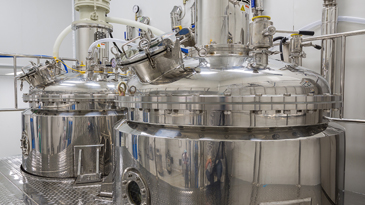As the specialty chemicals landscape becomes more competitive and complex, producers are turning to new technologies to elevate manufacturing performance. Manufacturing improvements can deliver a competitive advantage on multiple levels, as outlined in the white paper “Manufacturing Excellence in Specialty Chemicals: Six Essential Levers.” Here we’ll explore ways to improve the third lever, asset effectiveness.
Customers turn to AspenTech when they want to:
- Understand and eliminate causes of downtime, process inefficiencies and quality losses.
- Forecast downtime and quality events that can’t be permanently eliminated.
- Improve flow through bottleneck operations.
- Leverage performance monitoring and analysis to optimize the use of assets with the most profitable product mix.
Eliminating causes of downtime, process inefficiencies and quality losses
To achieve peak asset effectiveness, it helps if manufacturers measure overall equipment effectiveness (OEE). This allows them to determine how well equipment is being used — not just how long it’s running — and to pinpoint opportunities for improvement. Then, empowered with the knowledge of how much OEE varies from peak expectations and why, the manufacturer can prioritize and drive improvements in the process.
For example, a line which delivers a high production volume, but with a 40 percent defect rate, would move closer to peak asset effectiveness by identifying and eliminating or minimizing the cause of the defects. Similarly, while equipment will always require maintenance, chemical producers who monitor OEE will better understand the causes of unplanned downtime, which enables elimination or minimization of losses due to those causes. If you are making more than one product, transition losses are also unavoidable, but monitoring will allow you to minimize this point of loss as well.
Forecasting and minimizing the impact of events that can’t be eliminated
Not all causes of quality losses or downtime can be eradicated. However, many can be predicted. The ability to forecast quality losses and pending equipment failures enables the manufacturer to minimize the impact, which is a powerful way to maximize asset effectiveness. Online analytics tools like Aspen Mtell® and Aspen ProMV™ provide advance notice of pending equipment failures and quality failures. Models such as those developed using Aspen Plant Scheduler™ can minimize the impact of changing orders, quality problems and equipment availability.
Specialty chemical producers gain a clear path to improving asset effectiveness by knowing when equipment is likely to break and quality failures are likely to occur, which then provides the necessary time to avoid, control and/or plan for the event.
Focusing on the bottlenecks
In a complex manufacturing facility, measuring asset effectiveness is more important for some assets than for others. Bottlenecks matter more than anything else with respect to productivity – but they may not always occur at the same piece of equipment or stage in the process. Studying when and how bottlenecks change allows specialty chemical manufacturers to learn what’s driving or limiting productivity.
Using empirical or first principle models to understand where bottlenecks occur enables timely responses to improve asset effectiveness. Software modeling solutions like Aspen Fidelis Reliability™ can pinpoint the exact causes of bottlenecks, even as obstructions move around the plant. Simulation tools such as Aspen Plus can be used to visualize and identify bottlenecks associated with physical and chemical limits including chemical and phase equilibria and equipment hydraulic constraints. These tools help engineers build a deeper understanding of the process and equipment to avoid limits and to optimize operating conditions to maximize capacity while maintaining product quality constraints.
Performance monitoring to achieve peak asset effectiveness with the greatest profit
Most manufacturers need a diverse product portfolio to meet customer demands and revenue goals. As such, some manufacture products on equipment that wasn’t ideally designed to make them because those products are more profitable. This may lead to significant losses in line speed (productivity) and quality. Occasionally, partial or incomplete batches occur in order to meet delivery requirements for critical customer orders.
Fully understanding and managing the impact of slower run speed requirements, partial campaigns/batches and quality constraints is important when deciding on the best product portfolio. OEE targets should be set with the goal of maximizing profit. OEE monitoring against those targets provides important insight into the available levers to maximize not only production but also profit.
Ultimately, the ability to be sensitive to change and respond when it occurs is essential to maximize asset effectiveness. Specialty chemical producers using asset performance management monitoring and online modeling solutions in partnership with manufacturing execution and production systems, all from AspenTech’s comprehensive portfolio, have seen two to four percent improvements in OEE. The insight and value these manufacturers gain from AspenTech solutions has been crucial in driving best practices that boost asset effectiveness.
Learn more in the white paper Manufacturing Excellence in Specialty Chemicals: Six Essential Levers.






Leave A Comment